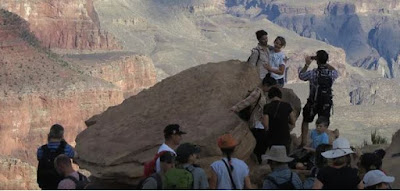A piece of the north-west shoreline of Tasmania is the Grand Canyon's departed cousin.
A paper as of late distributed in the diary Geology by geologists at Monash University pursued a hunch about these stones:
Picture: Peter Farquhar/Business Insider
They're a piece of an extremely well known piece of land, Rocky Cape National Park, where give in middens uncover proof of Aboriginal occupation from somewhere around 8000 years prior. It's been formally perceived as "pinmatik" ("peen mah teek") since 1991.
In any case, a huge number of years prior, it was a piece of a megacontinent known as Rodinia, and joined to what is currently known as the west shore of the USA, 13,000km away.
Specifically, it has bits of the Grand Canyon in it, and that makes it, extremely fascinating for earth science specialists.
Rodinia was framed when an even more seasoned supercontinent known as Columbia broke separated, however you won't discover any Rodinian fossils at Rocky Cape, on the grounds that Rodinia existed one billion years back, a long time before earthly life had shaped.
It started separating around 700 million years prior.
Picture: Peter Farquhar/Business Insider
The revelation was made by Jack Mulder, an exploration individual at Monash University in Melbourne, who thought the stones appeared to be like those in the Grand Canyon, and chose to test his hypothesis.
The hunch ended up being on the cash. Rocks from the two districts had comparative stratigraphy, depositional age, and they contain coordinating hafnium isotopes readings.
Mulder could follow where the old sand and mud originated from by dissecting the geochemical unique finger impression of minor grains of the mineral zir-con, which makes up a little extent of the sedimentary rocks.
"When we contrasted the Tasmanian rocks with comparable matured shakes close-by in Australia, we found that in addition to the fact that they looked altogether different, they had particular zircon fingerprints. Rather, the baffling Tasmanian rocks look strikingly like the one multi year old sedimentary rocks found close to the base of Grand Canyon in Arizona," he says.
"Notwithstanding shaping in the meantime and in comparative land condition, the old sedimentary shakes in Tasmania and Grand Canyon share a similar zircon unique finger impression. Together, this proof backings the elucidation that these now broadly isolated shake units once framed piece of the equivalent sedimentary bowl."
That dates pinmatik back as much as 1.1 billion years to the late Mesoproterozoic time.
One such teacher, Alan Collins, at the University of Adelaide, Australia, revealed to New Scientist the paper indicates Tasmania "holds the key" to seeing how the planet was assembled.
It could enable future geologists to assemble full plate models of antiquated Earth, he said.
You can peruse a portion of the report here.
A paper as of late distributed in the diary Geology by geologists at Monash University pursued a hunch about these stones:
Picture: Peter Farquhar/Business Insider
They're a piece of an extremely well known piece of land, Rocky Cape National Park, where give in middens uncover proof of Aboriginal occupation from somewhere around 8000 years prior. It's been formally perceived as "pinmatik" ("peen mah teek") since 1991.
In any case, a huge number of years prior, it was a piece of a megacontinent known as Rodinia, and joined to what is currently known as the west shore of the USA, 13,000km away.
Specifically, it has bits of the Grand Canyon in it, and that makes it, extremely fascinating for earth science specialists.
Rodinia was framed when an even more seasoned supercontinent known as Columbia broke separated, however you won't discover any Rodinian fossils at Rocky Cape, on the grounds that Rodinia existed one billion years back, a long time before earthly life had shaped.
It started separating around 700 million years prior.
Picture: Peter Farquhar/Business Insider
The revelation was made by Jack Mulder, an exploration individual at Monash University in Melbourne, who thought the stones appeared to be like those in the Grand Canyon, and chose to test his hypothesis.
The hunch ended up being on the cash. Rocks from the two districts had comparative stratigraphy, depositional age, and they contain coordinating hafnium isotopes readings.
Mulder could follow where the old sand and mud originated from by dissecting the geochemical unique finger impression of minor grains of the mineral zir-con, which makes up a little extent of the sedimentary rocks.
"When we contrasted the Tasmanian rocks with comparable matured shakes close-by in Australia, we found that in addition to the fact that they looked altogether different, they had particular zircon fingerprints. Rather, the baffling Tasmanian rocks look strikingly like the one multi year old sedimentary rocks found close to the base of Grand Canyon in Arizona," he says.
"Notwithstanding shaping in the meantime and in comparative land condition, the old sedimentary shakes in Tasmania and Grand Canyon share a similar zircon unique finger impression. Together, this proof backings the elucidation that these now broadly isolated shake units once framed piece of the equivalent sedimentary bowl."
That dates pinmatik back as much as 1.1 billion years to the late Mesoproterozoic time.
One such teacher, Alan Collins, at the University of Adelaide, Australia, revealed to New Scientist the paper indicates Tasmania "holds the key" to seeing how the planet was assembled.
It could enable future geologists to assemble full plate models of antiquated Earth, he said.
You can peruse a portion of the report here.






No comments:
Post a Comment